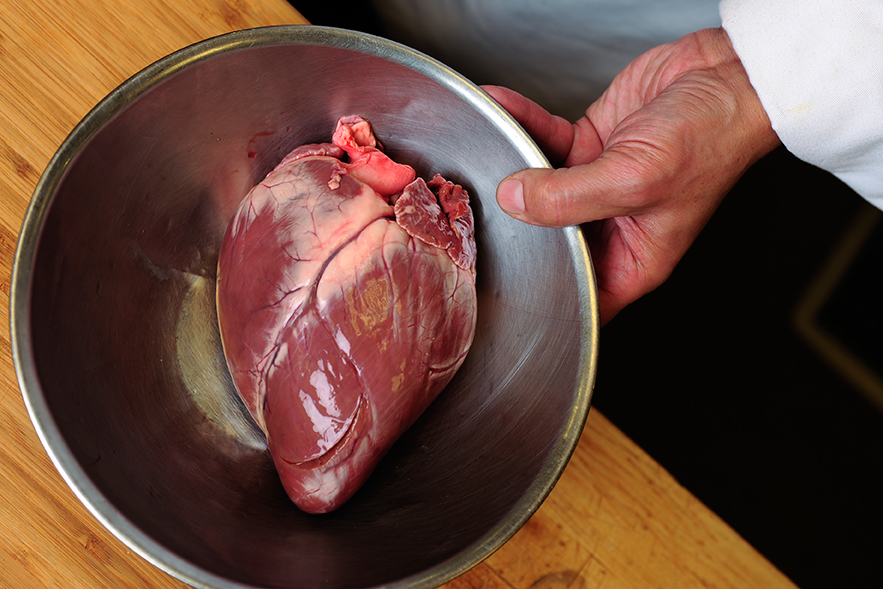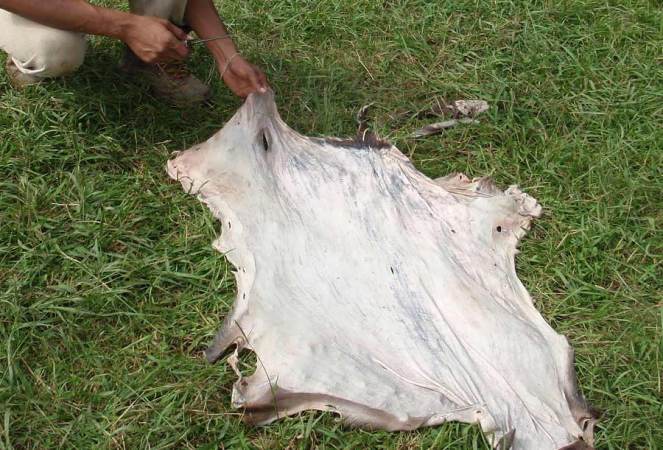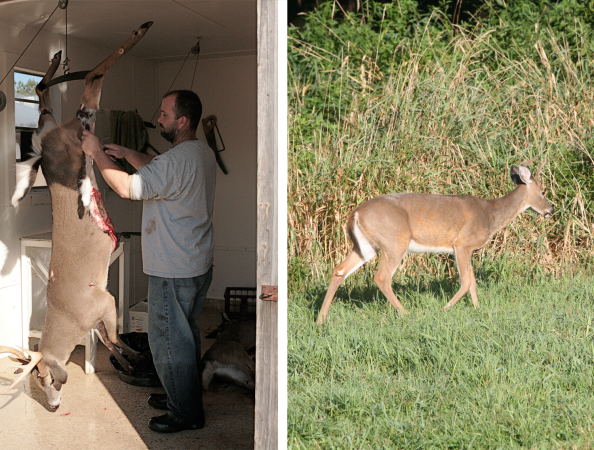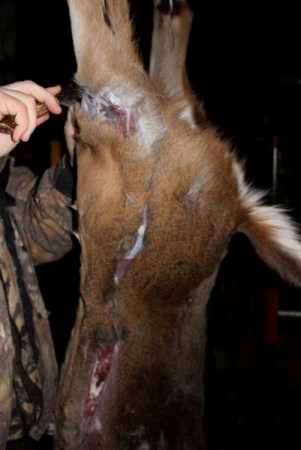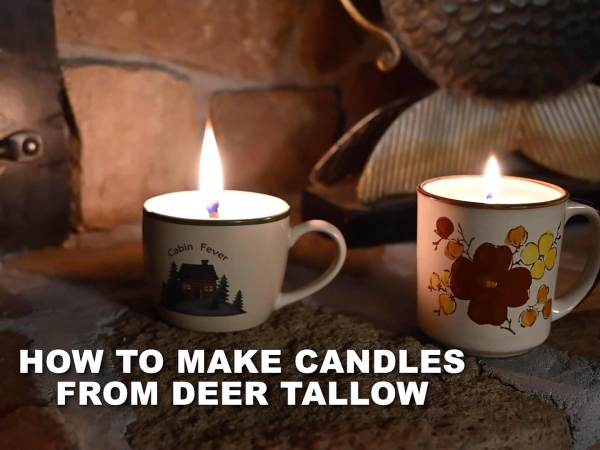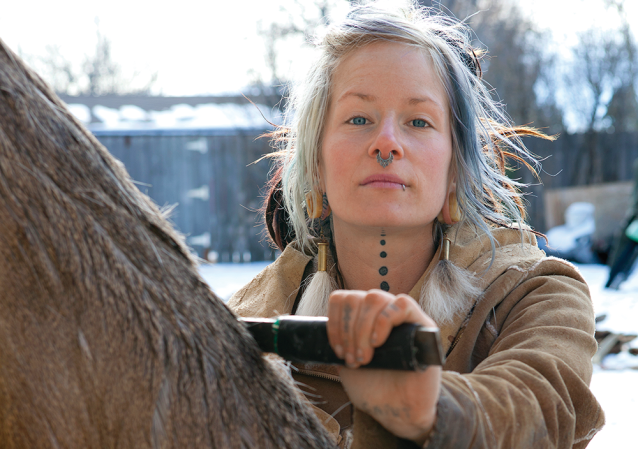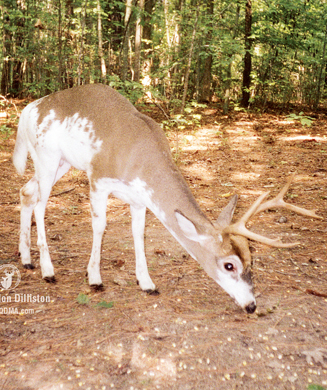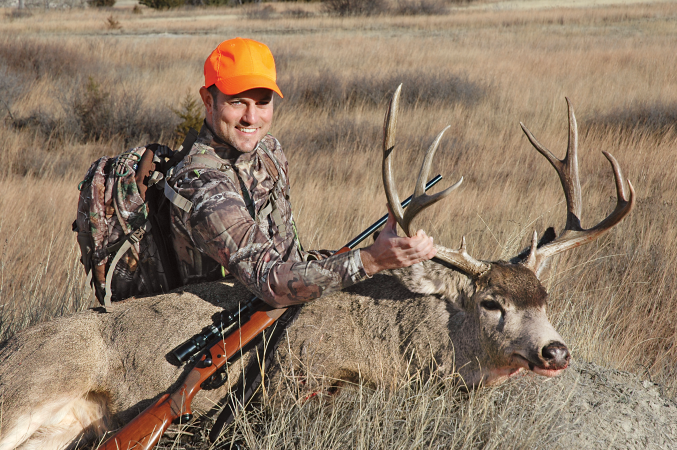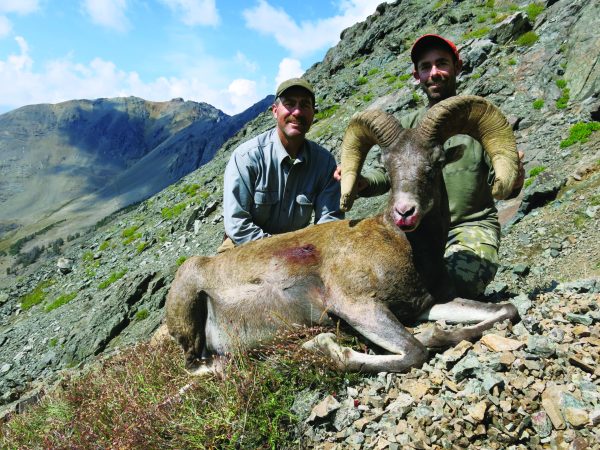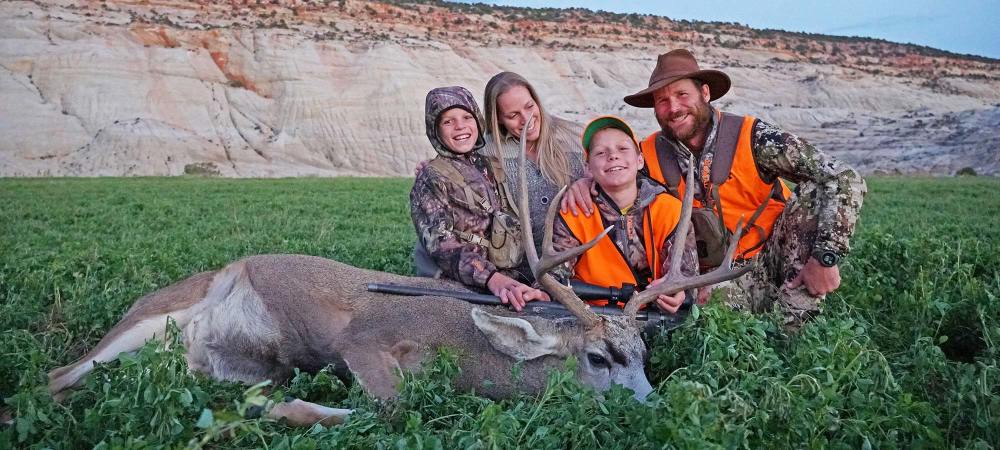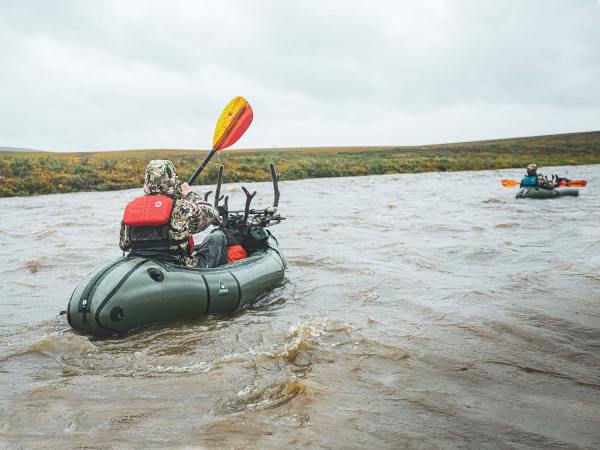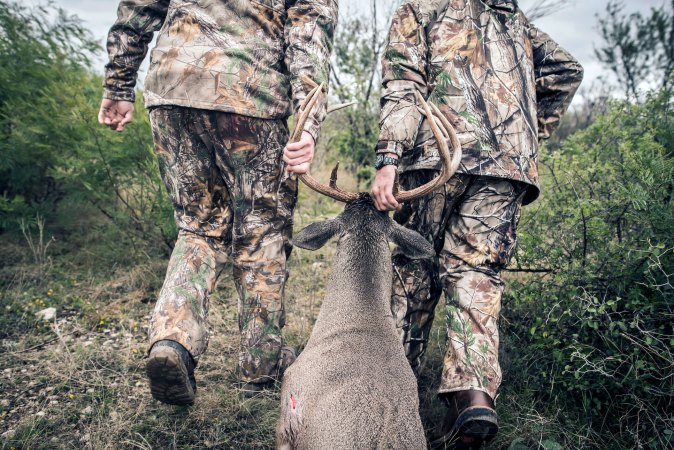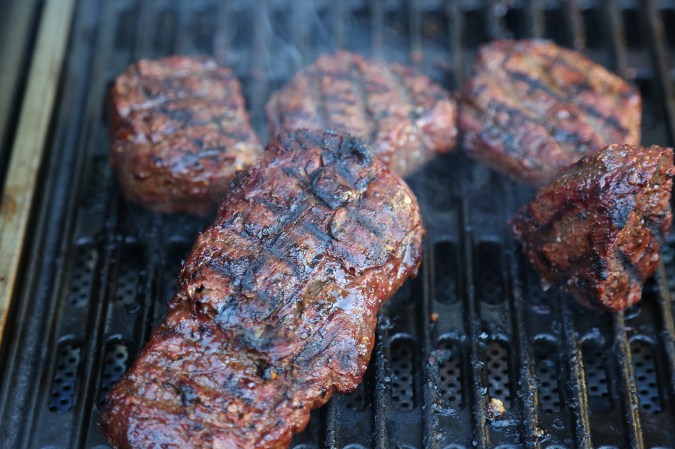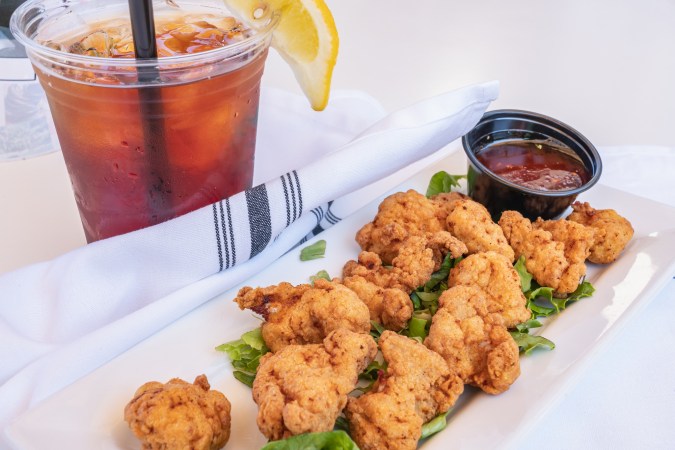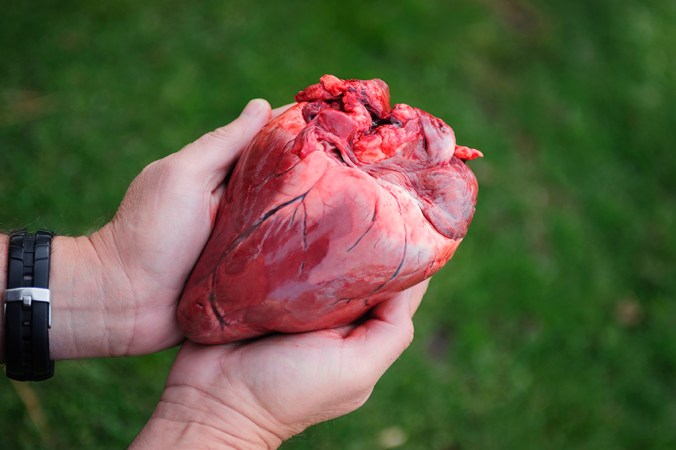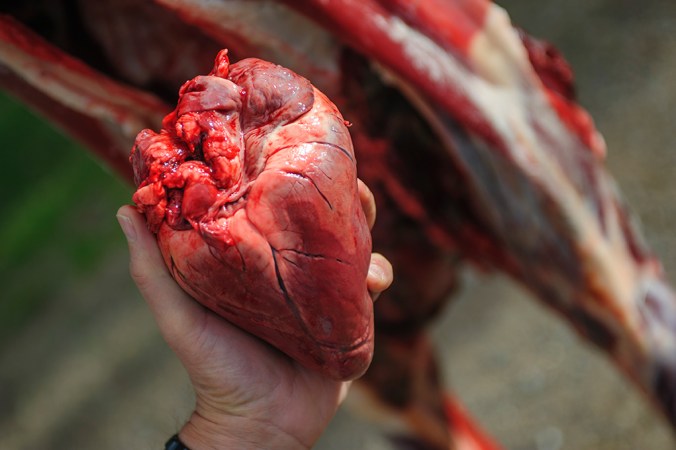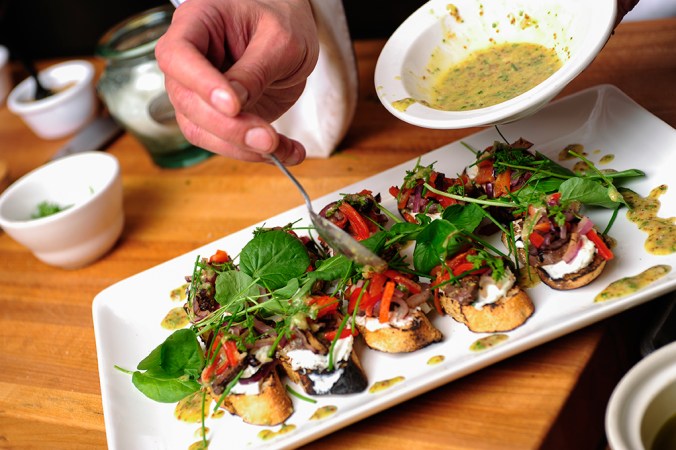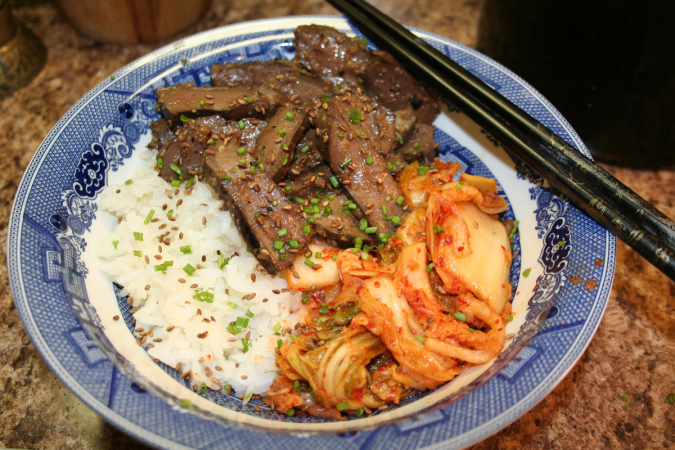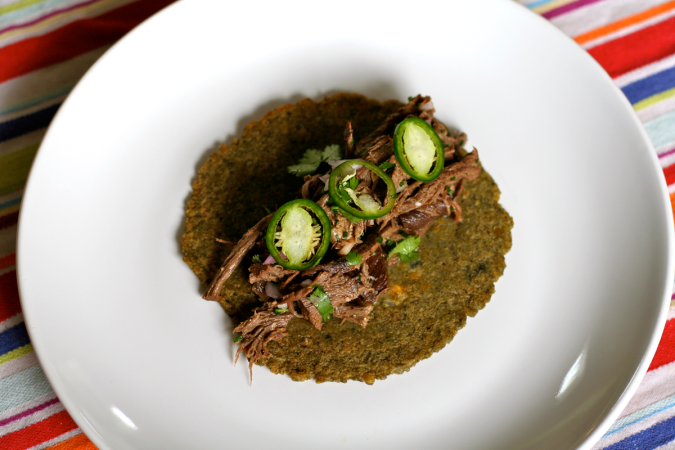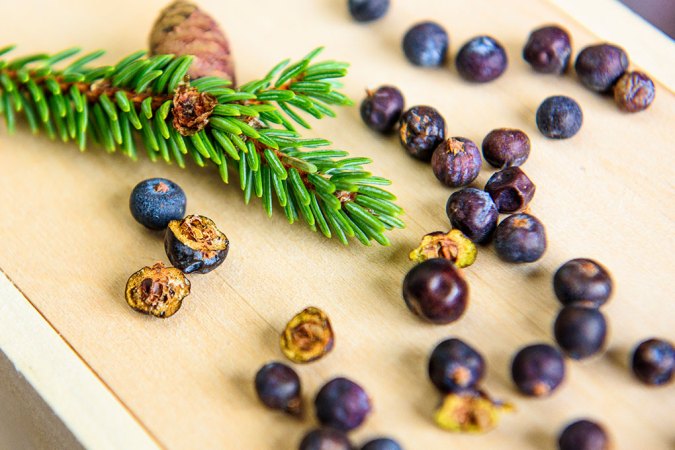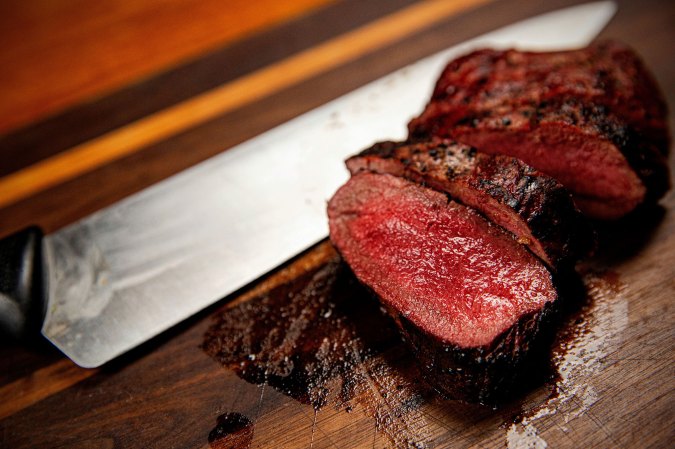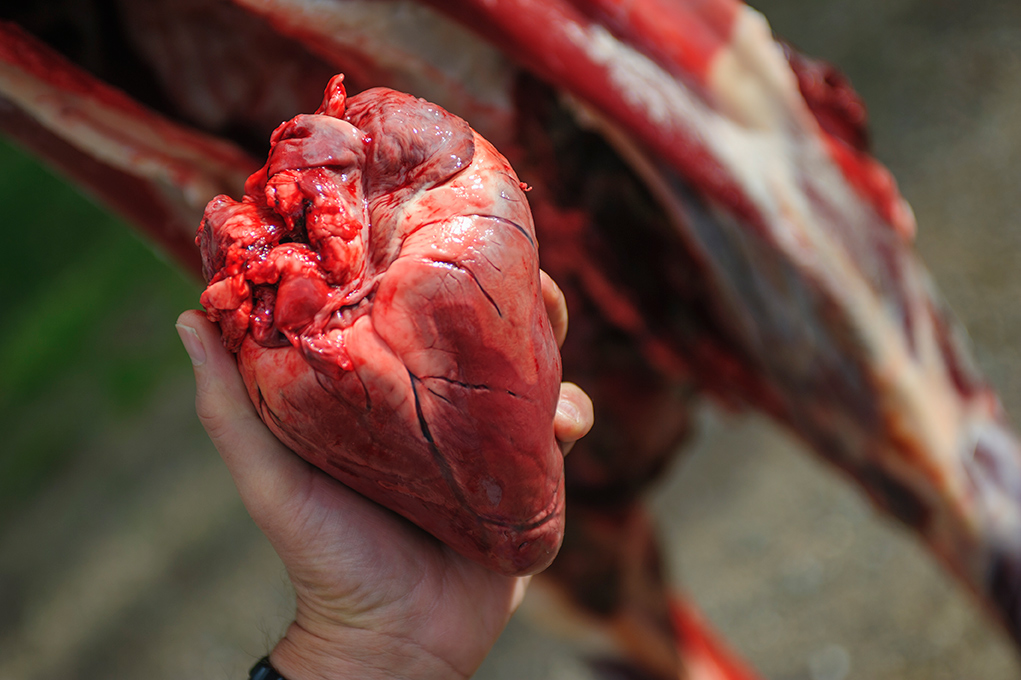
Many hunters throw away all the entrails when field dressing their deer, but they’re missing out. The heart is just another muscle, and one that’s hard to beat. Here’s a step-by-step guide to help you clean and trim the heart from your next deer.
1. Start with a Fresh Heart
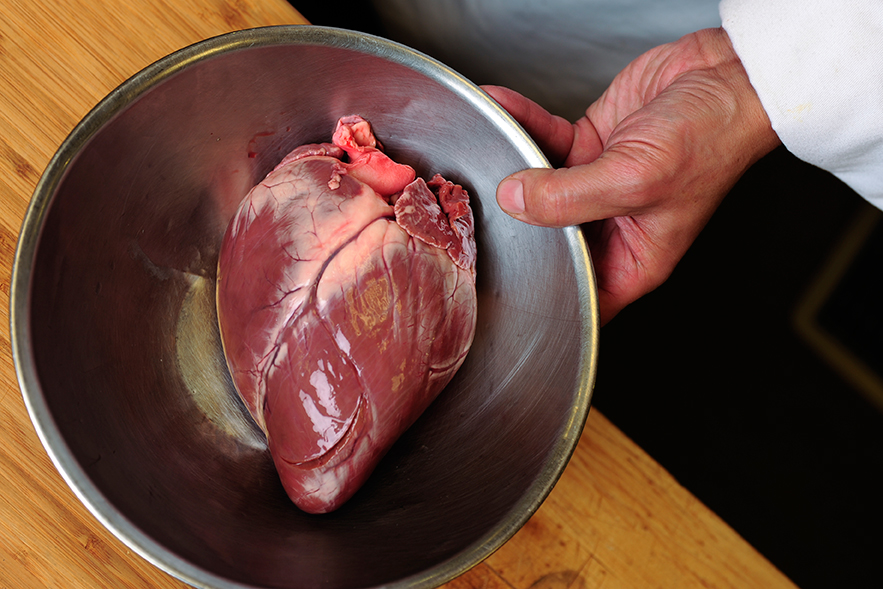
Rinse under cold water, then submerge and squeeze it several times to pump out any remaining blood.
2. Trim the Heart
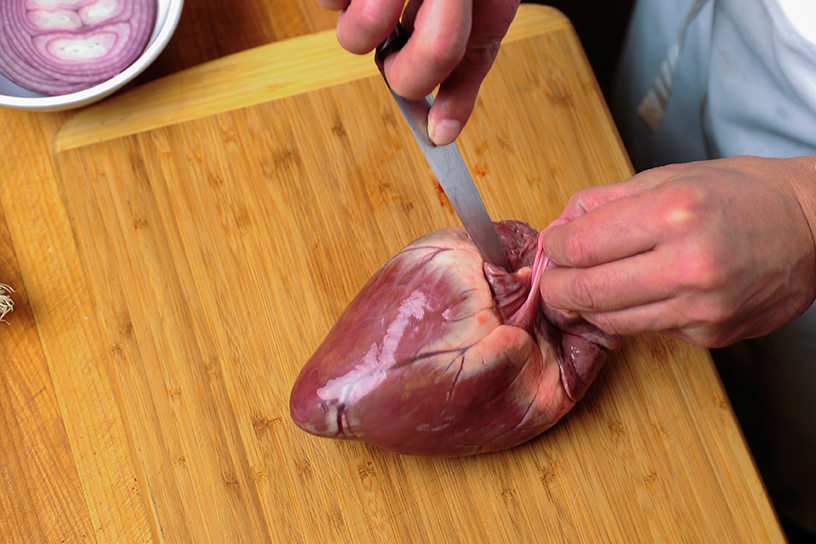
Using a sharp 6-inch knife, carefully trim excess fat from the main arteries of the heart.
3. Loosen the Top of the Heart
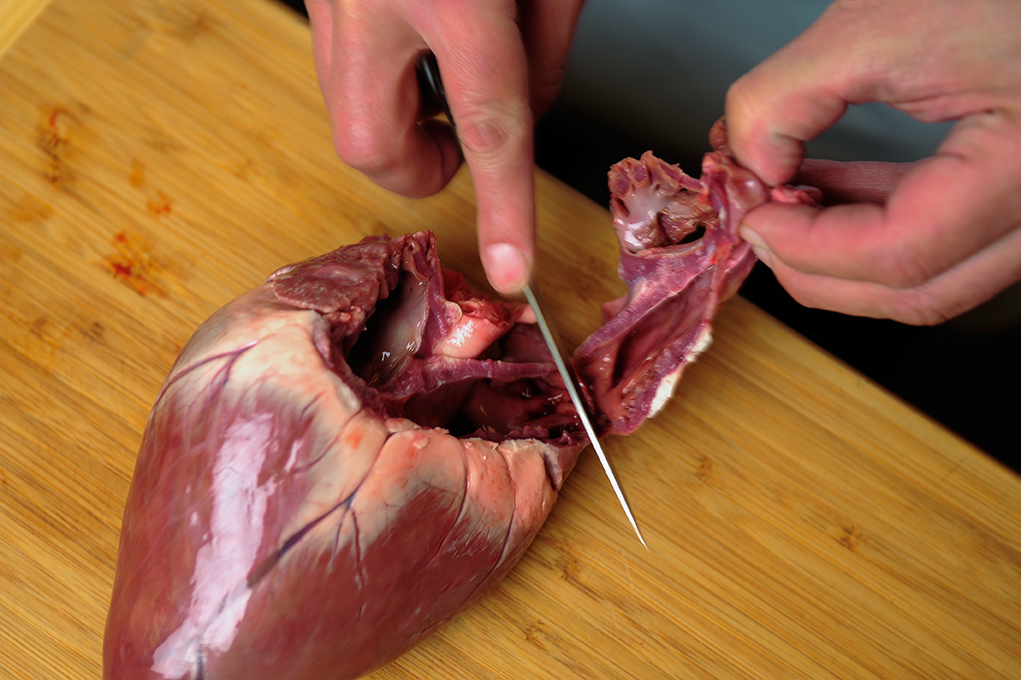
Cut off excess fat and tissue that remains from field dressing to open and loosen the top part of the heart.
4. Locate the Arteries
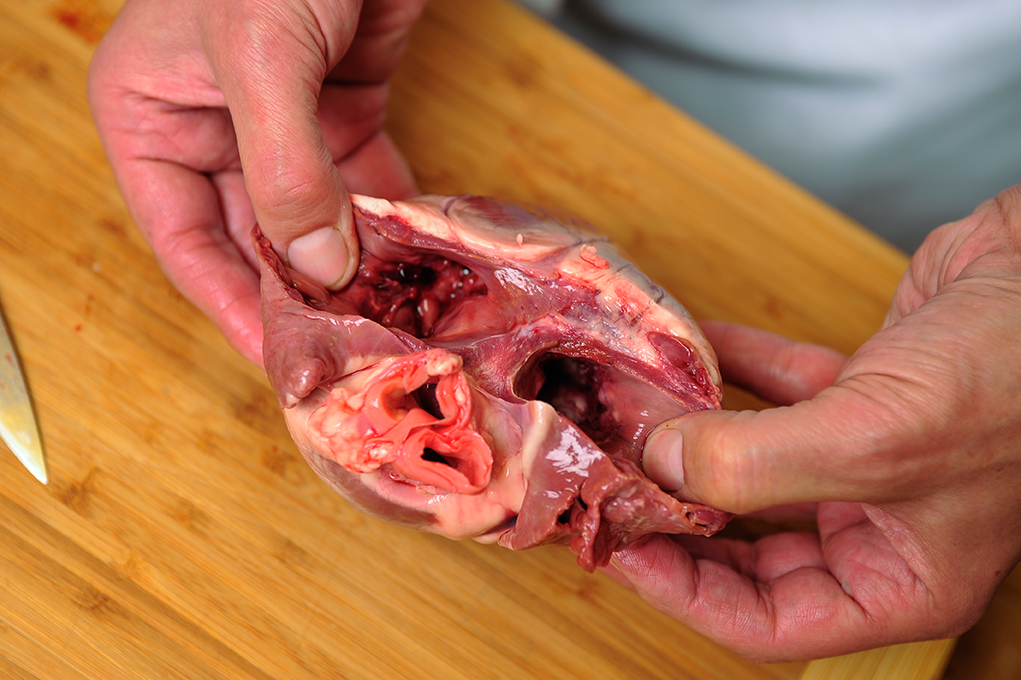
Stand heart upright and insert thumbs to locate main muscles and arteries.
5. Expose the Main Muscles
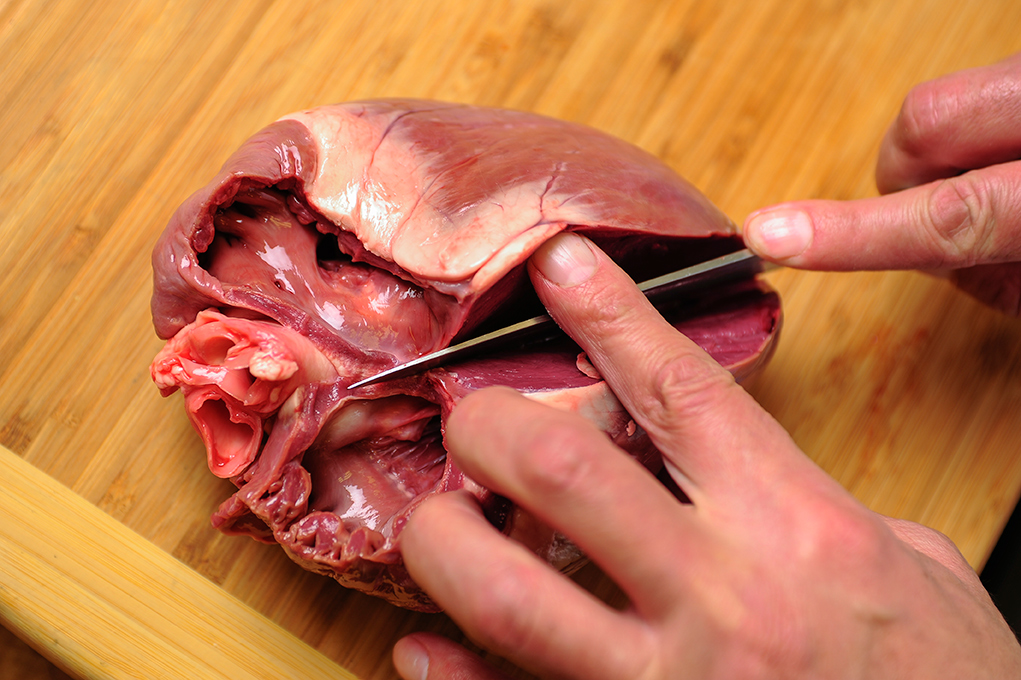
Clean cut along the main arteries to expose the main muscles. That cut will pretty much fall right in the center. You don’t want to cut all the way through. This is a butterfly cut, so take your time and and slice gently.
6. More Trimming
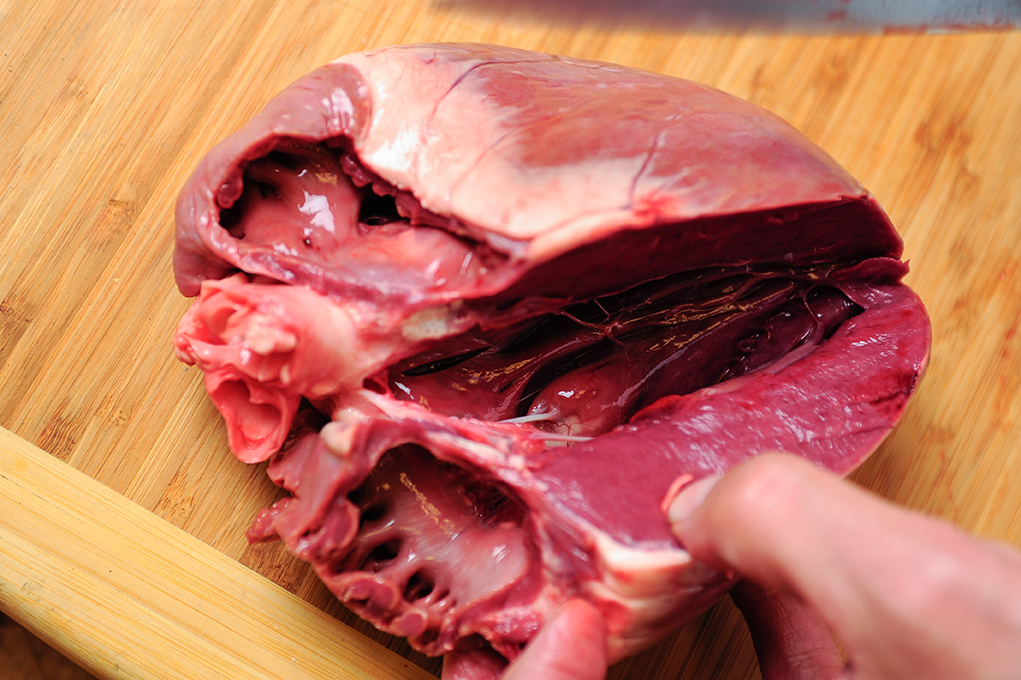
This is approximately what your cut should look like. Note the exposed meat along your cut, and the inside connective strands that help hold the heart together. Trim away any fibrous tissue that might be in the way.
7. Butterfly the Heart
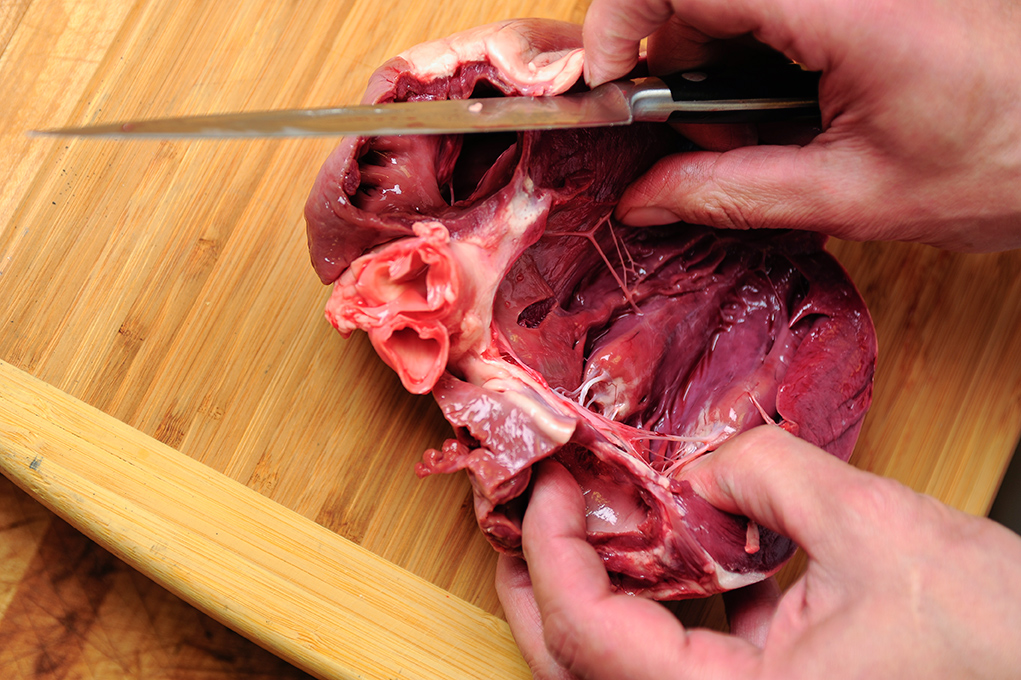
Butterfly the heart by pulling with your hands, opening the muscle and revealing more connective tissue and fiber.
8. Remove More Fat
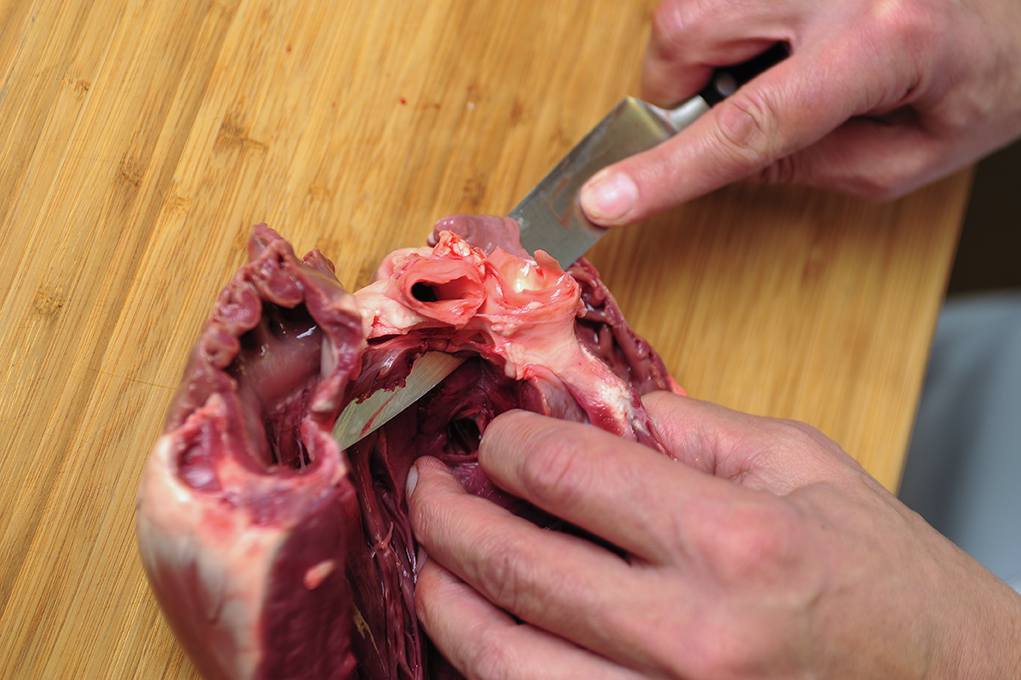
Remove excess fat and tissue from the top.
9. Cut Away Arteries
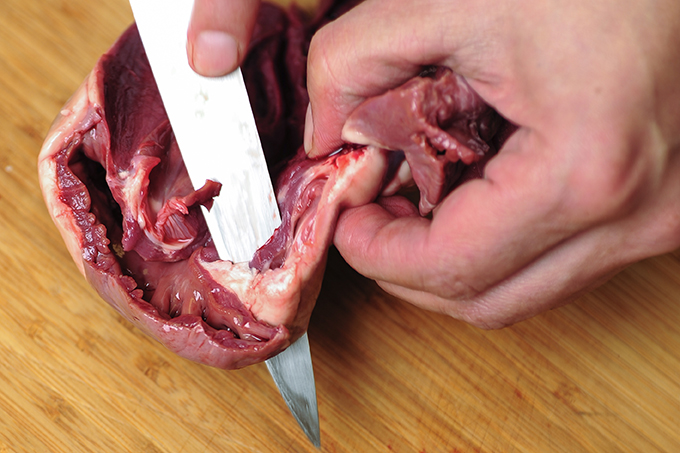
Cut away main valves and arteries.
10. Remove Fibrous Tissue
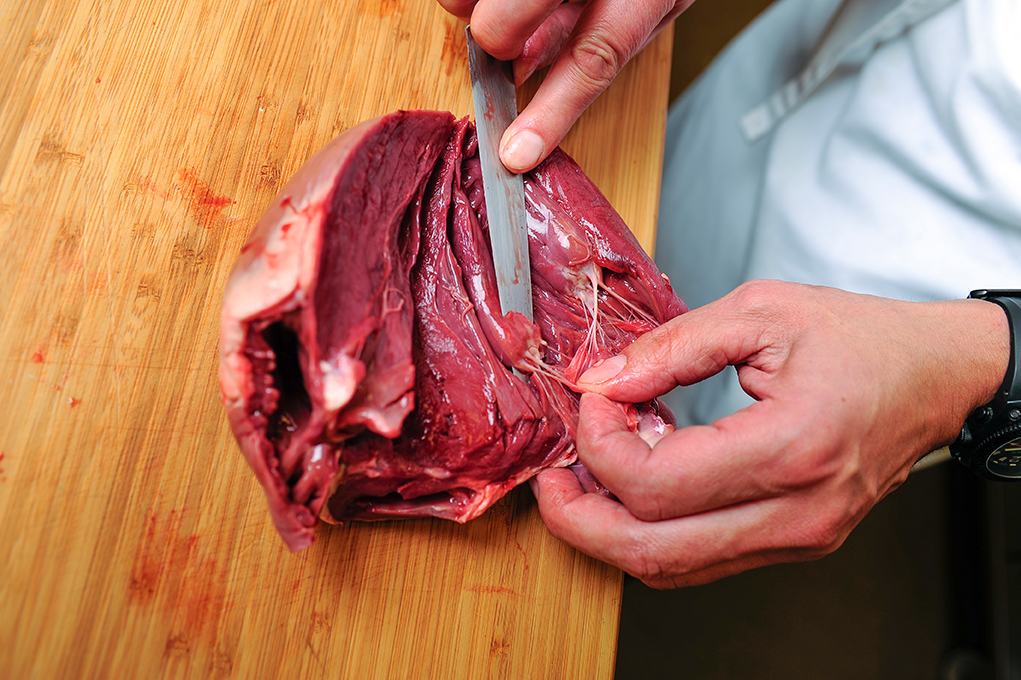
With the tip of your knife start removing fibrous tissue. Fishermen who know how to finesse a filet knife will be particularly good at this.
11. Expose Heart Chambers
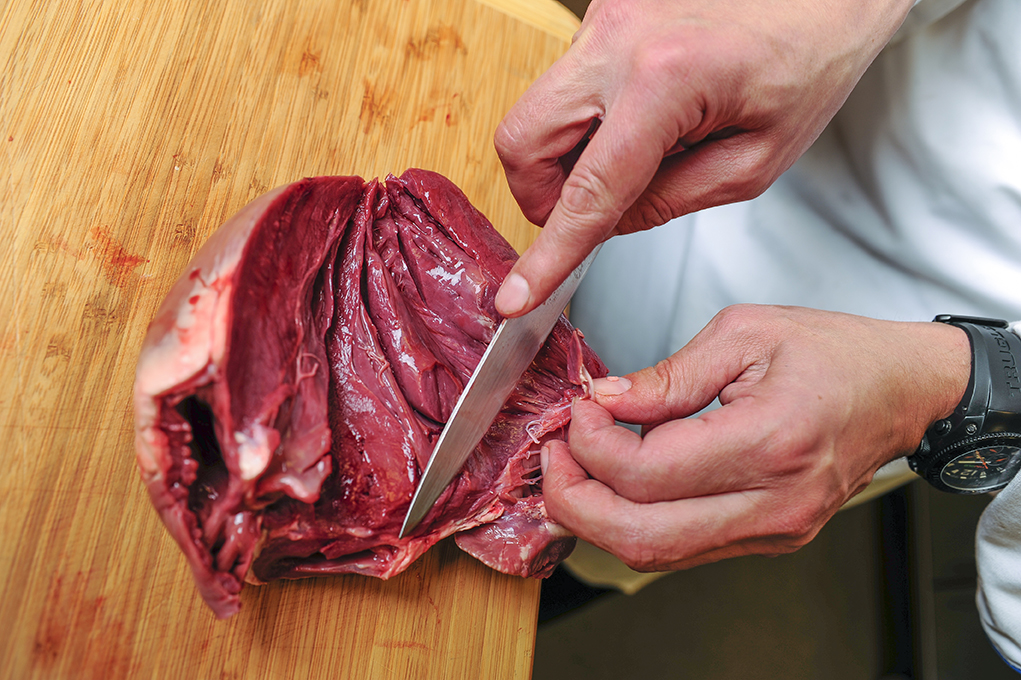
Expose the different chambers and sections and trim further.
12. Continue Cleaning
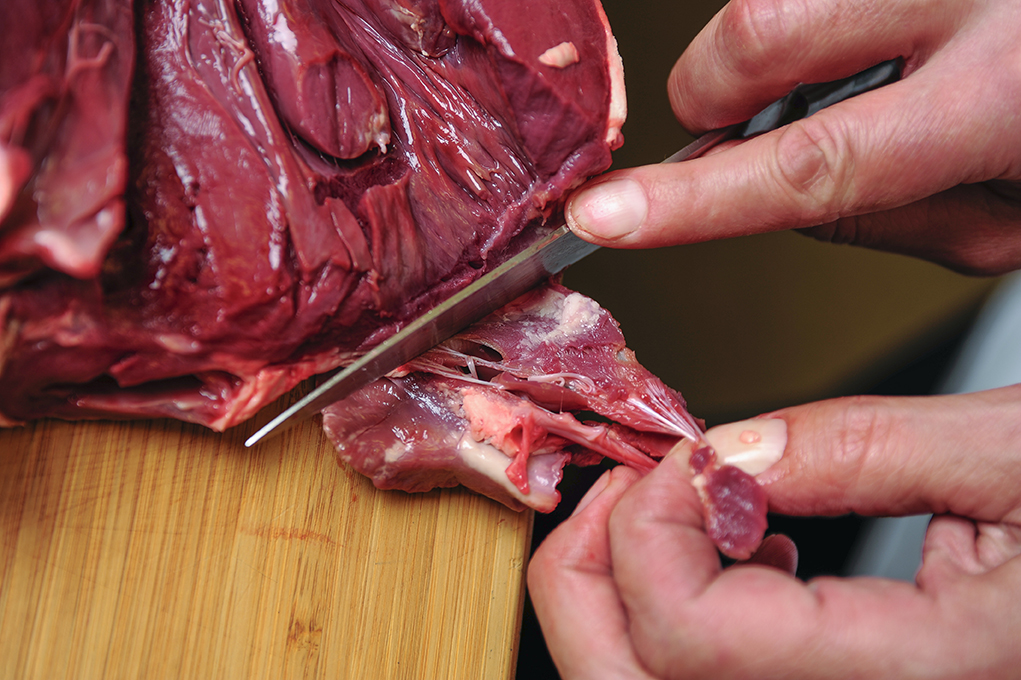
The amount of trimming required will depend on your heart. Here, we continue cleaning and trimming away more fat.
13. Make a Cut at the Top
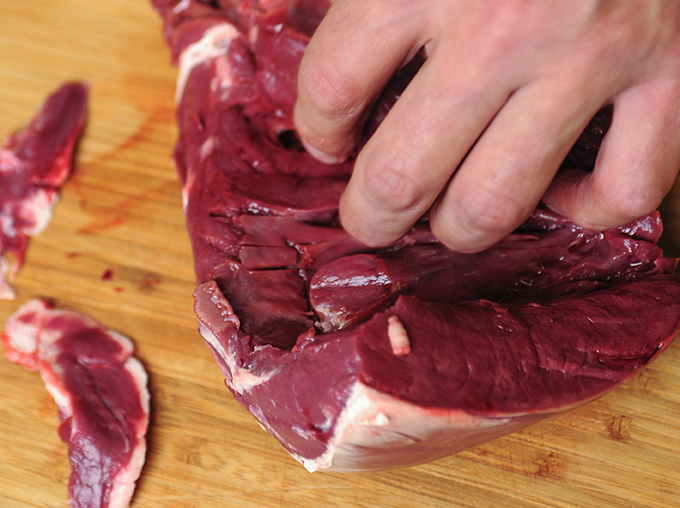
Square up the cut by making an even, straight cut across the top.
14. Continue Trimming
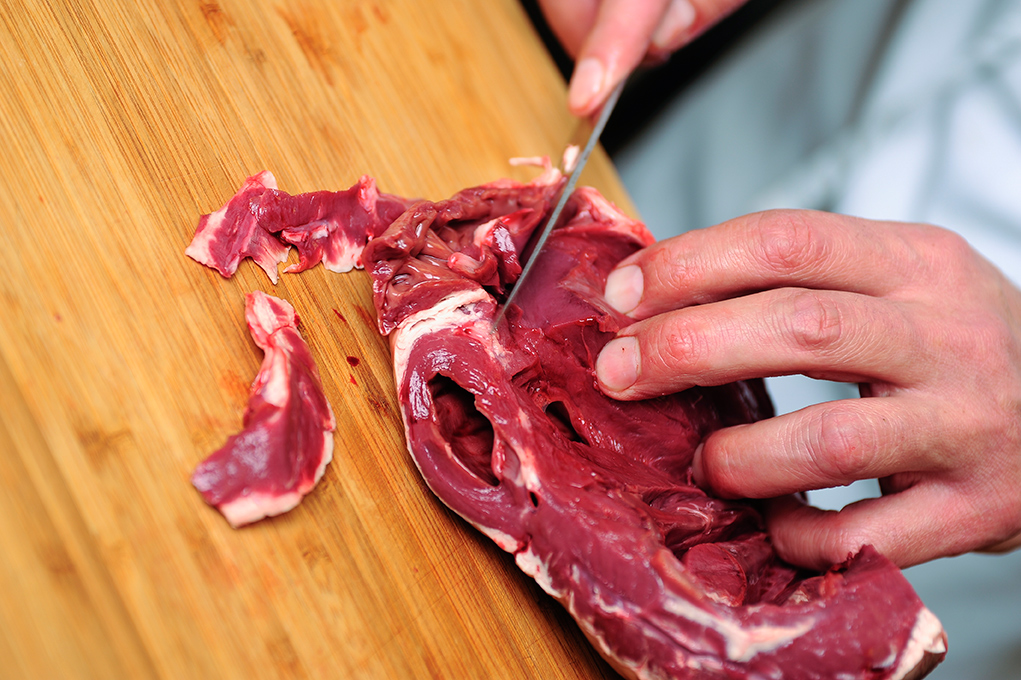
Cleaning and trimming continues as more of the heart become visible.
15. Inspect for Connective Tissue
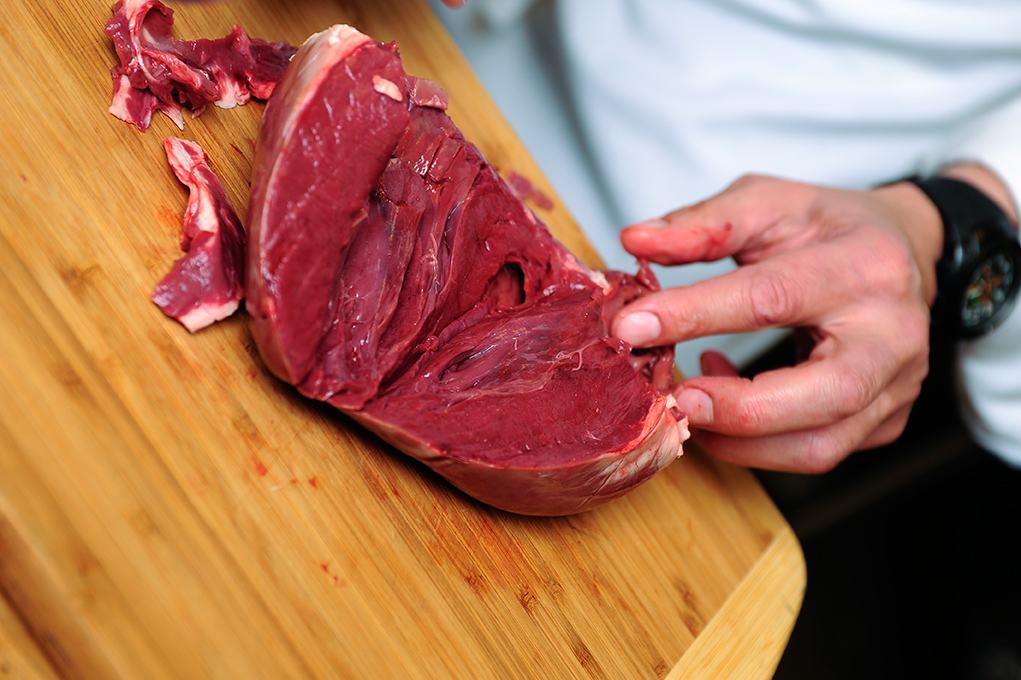
Inspect for areas where fiber and connective tissue might remain.
16. Remove Last Fat
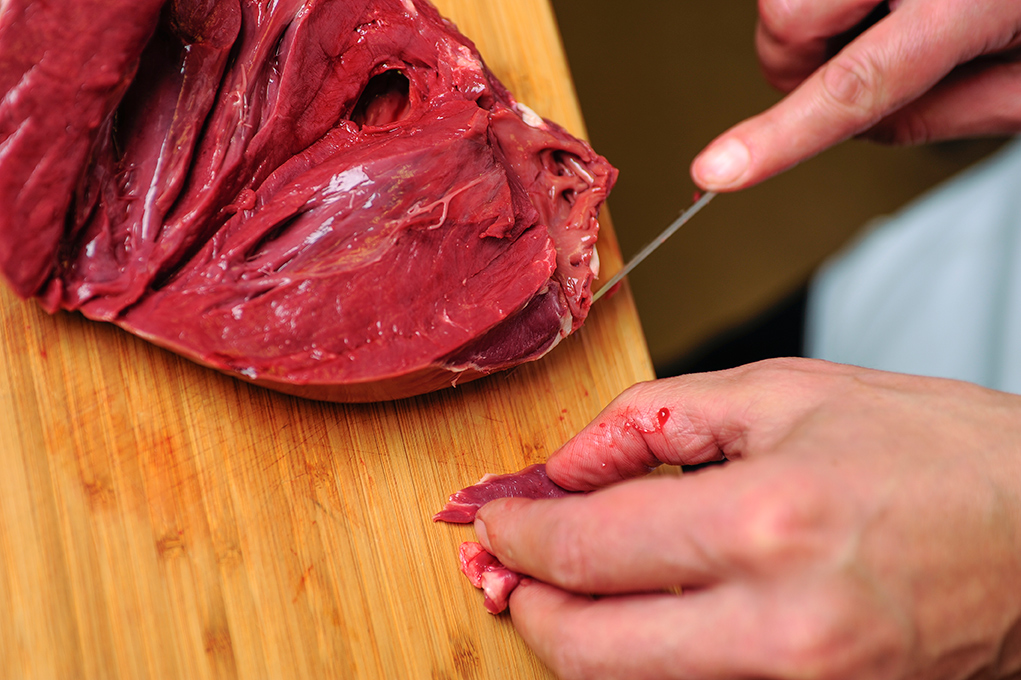
A few last trimming cuts to remove a bit more fat.
17. Assess Heart
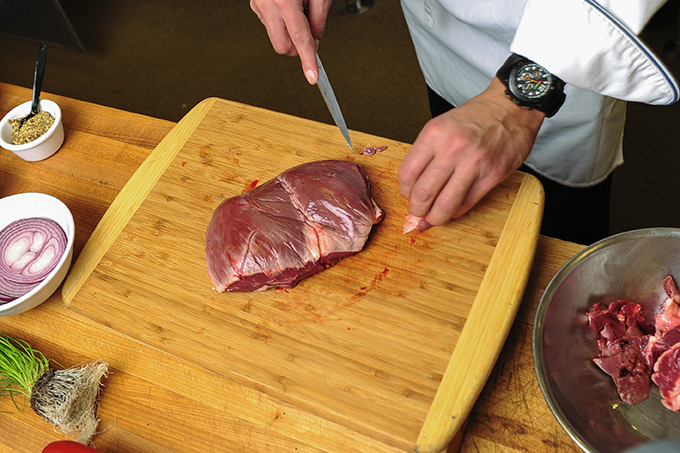
Assess the front side of the heart to determine whether further trimming is necessary. You don’t need to remove every last speck of fat as it will sear nicely and add flavor once it hits pan.
18. Set Aside Trimmings
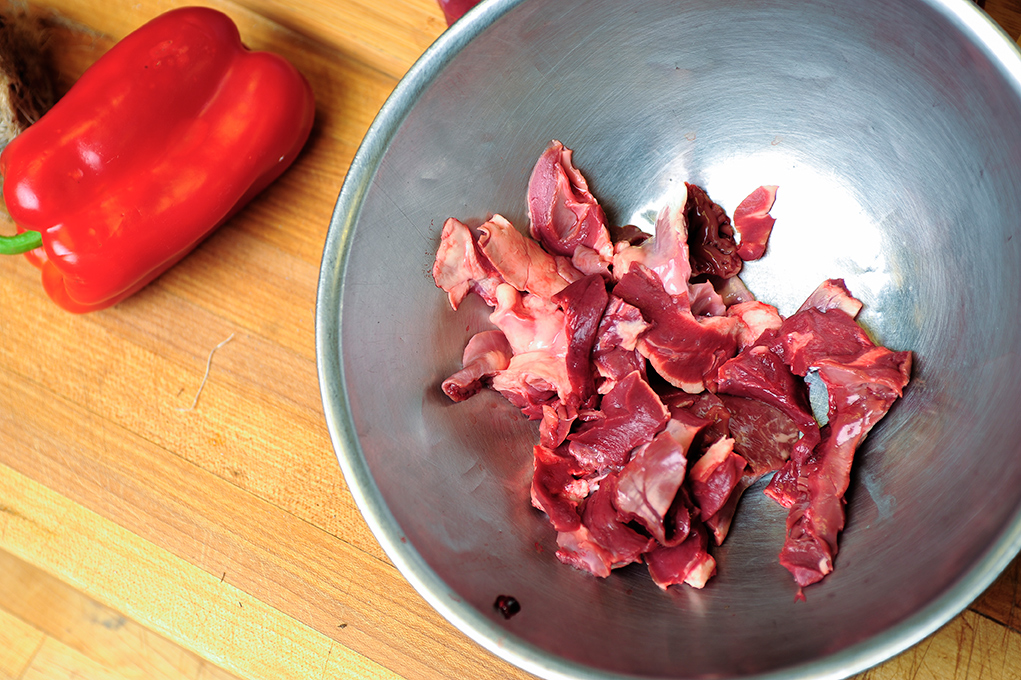
Save the trimmings for sausage making, stew, or soup.
19. Cut Into Strips
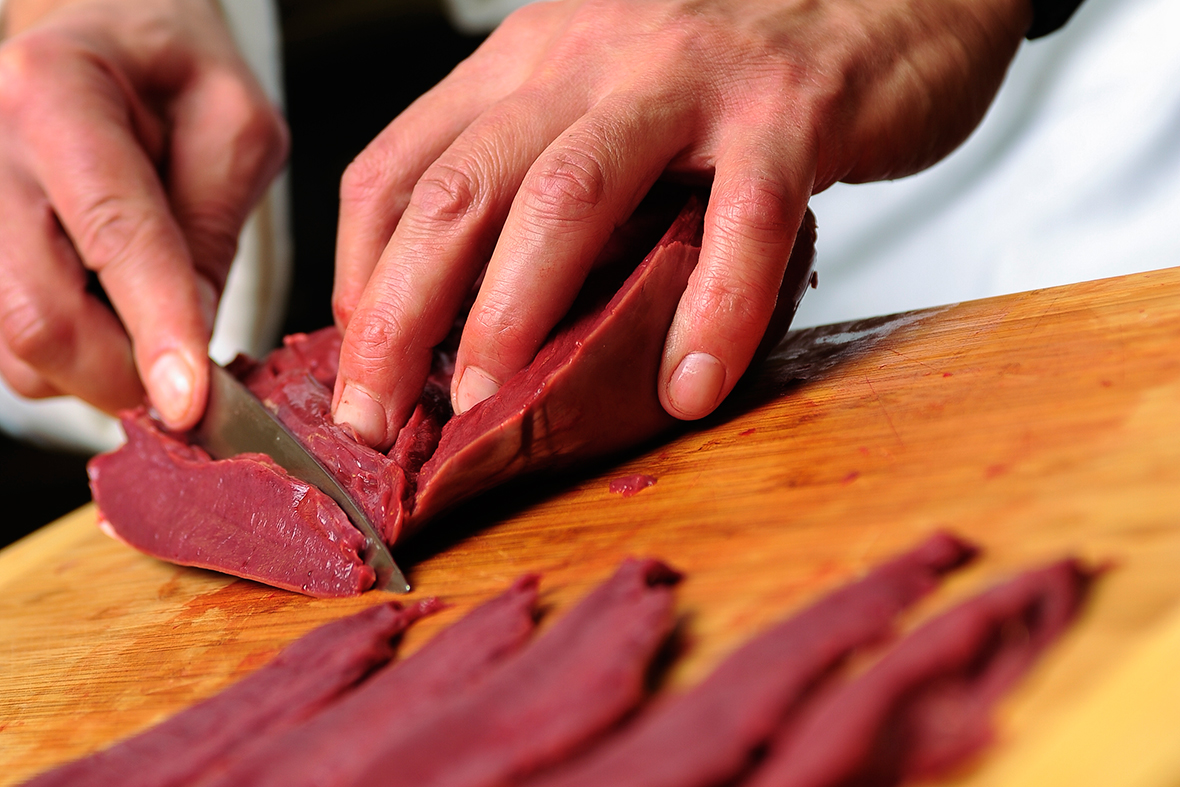
Cut large muscle in thin strips going against the grain of the meat. These will be entrée size.
20. Ready to Grill
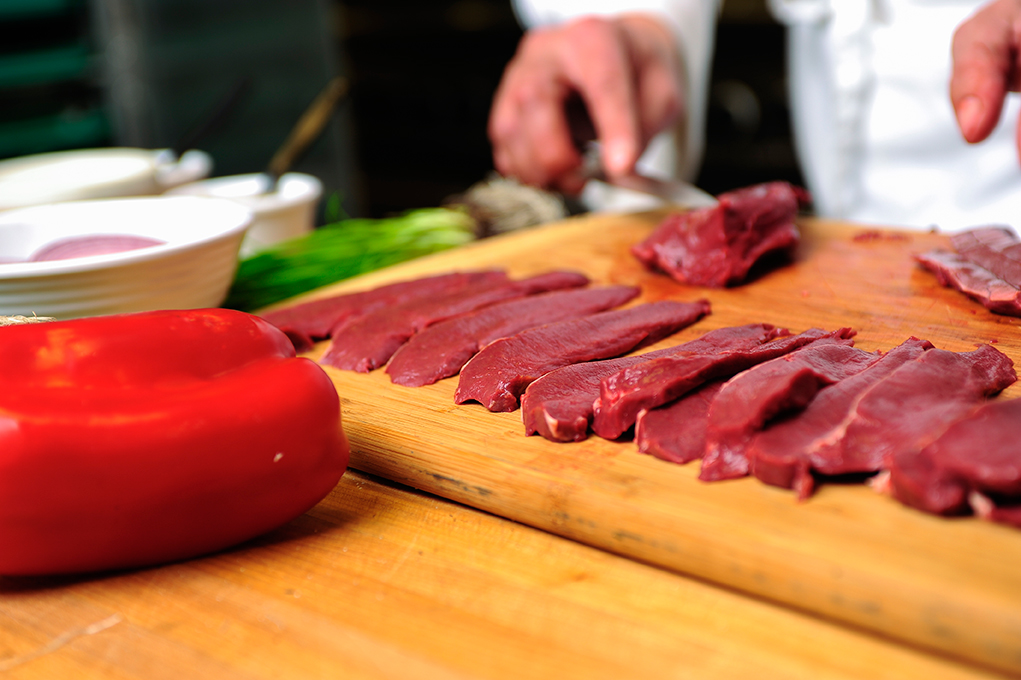
Large, thin strips ready for quick grilling or charring. If you are in the field and want something really simple, combine some olive oil, lemon juice, a little minced shallot, or onion, and some crushed oregano, and then throw it on a HOT grill for a minute on each side.
21. Cut Small Pieces
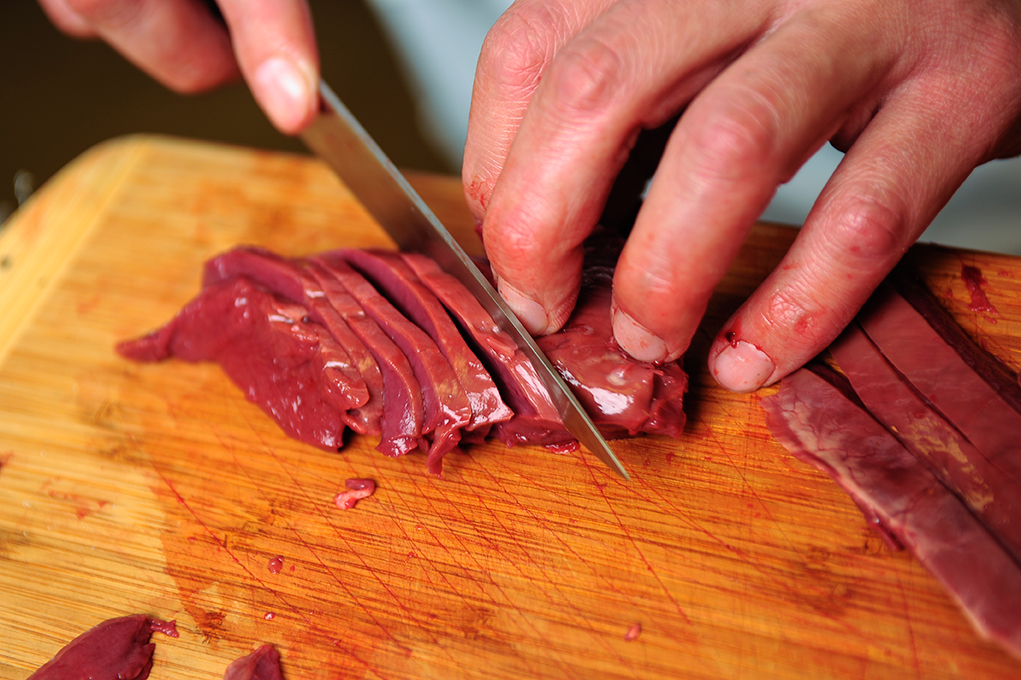
Cut small heart muscle for bruschetta, or small appetizers.
22. Ready for Bruschetta
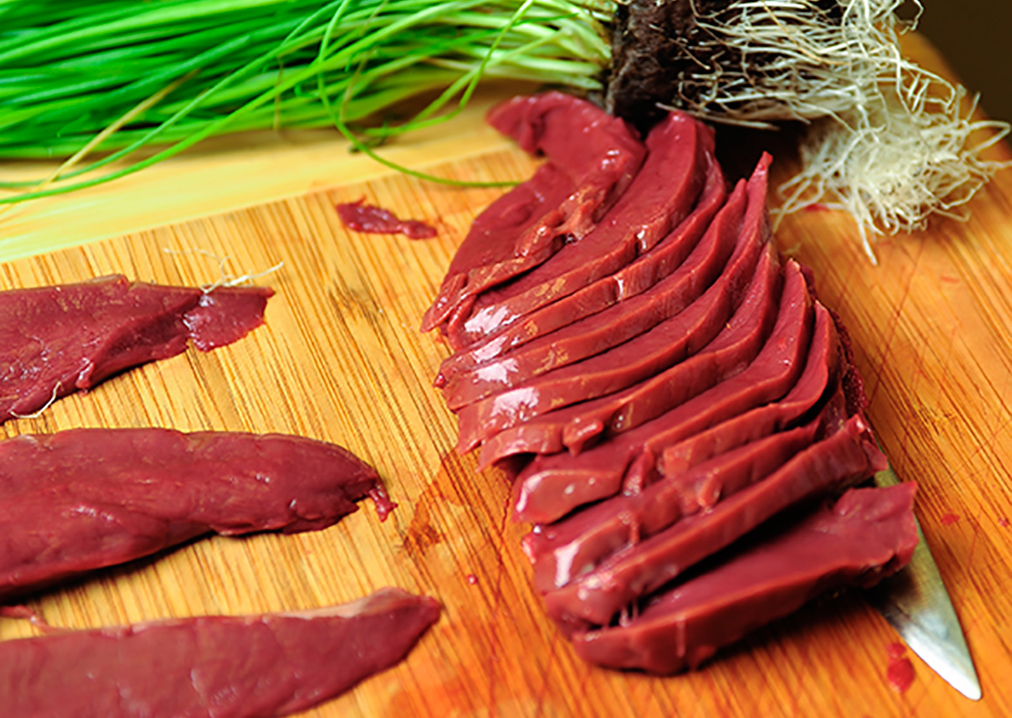
Small strips are ready for Venison Heart Bruschetta.
Why Venison Heart is Not Bizarre Food –– with Andrew Zimmern
Hunters typically agree the best field-to-camp-table cut of meat is freshly harvested backstrap, or tenderloin prepared over an open flame with friends. But many hunters have yet to try the heart from their big game harvests. Take venison heart. When prepared correctly, it “…is one of the most sublime eating experiences on the animal,” says chef Andrew Zimmern, who is both a sportsman and the host of Travel Channel's Bizarre Foods.
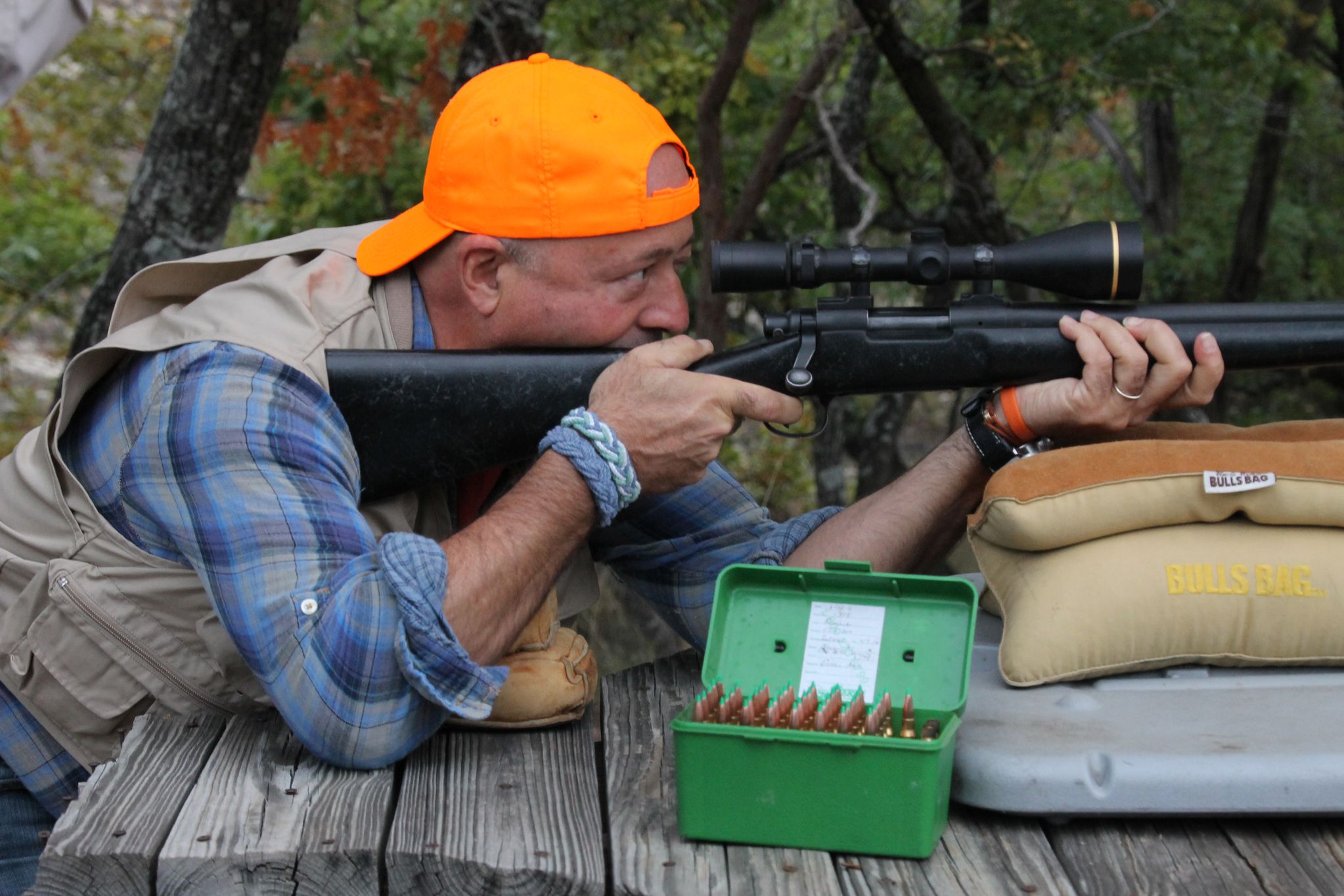
Outdoor Life: Why do you think venison heart gets a bad rap?
AZ: Most people in the U.S. are of the opinion that heart shares the funky minerally taste and texture of other visera, or entrails of a harvested animal; like liver, or intestines. Not so. In fact, it can be mistaken for a luxury cut of meat, and can be as tender as filet mignon when prepared right. It's a muscle with one distinguishing factor: It lacks any real presence of grain like you find in flesh cuts.
OL: Is there a common mistake people make when preparing venison heart?
AZ: Over cooking is the biggest problem most home cooks have with heart, or a luxury cut like tenderloin. The experience I have with heart and other organs is that if you over cook liver, kidney, or heart you have an inedible piece of meat. If you cook rare to medium-rare you have one of the most sublime eating experiences on the animal. It confounds me why people cook a liver until it's incinerated. You are chewing on this dry crumbly piece of chalk that has nothing but tannic and burnt flavors left on it.
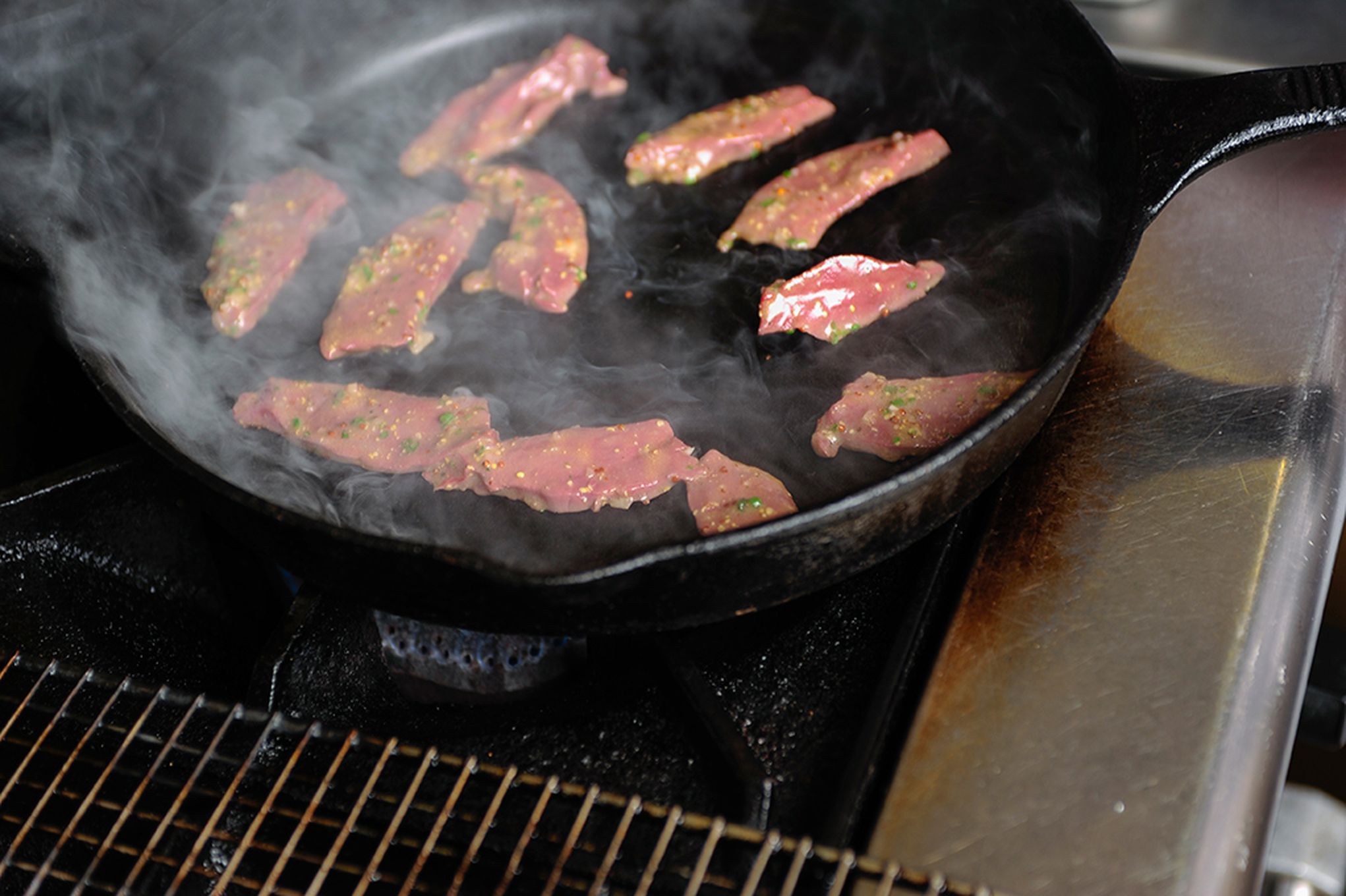
OL: Is there a right way to cook a venison heart?
AZ: Out in the field, what I often do if ice or a cold stream is available, is I'll chill it for a while. Then I pull it out and go straight to the fire. I actually put it into the fire; laying it directly on the coals—basically charring, or blackening the outside, and serving the inside with a warm red center. An animal's heart needs to be charred rare. Myself, Alton Brown, and Hank Shaw are pretty famous for espousing this technique. You can also do it on a grill or grate. The key is to get it as hot as Hades—but only for a matter of minutes. It will be butter-tender when it's medium-rare or rare—but inedible when it's cooked more than that.
OL: Do you marinate it, or season it prior to charring?
AZ: In the spirit of traveling light, I rub it with olive oil and sprinkle with salt and pepper. Freshly harvested food tastes amazing when it's prepared outdoors. Whether it's Walleye, dove hearts, or venison. Cooking meat properly over an open flame within hours of harvesting has the ability to satiate a hunter's hunger in a primal, almost inexplicable way.
OL: You don't stick it in there whole, do you?**
AZ: No. I butterfly it. You want to trim away any fat and take out as much connective tissue as you can in the valves because on larger animals those can be kind of chewy. Then I pound it with the heel of my hand so it lays flat. I treat it the same way as I would a flat iron steak.
OL: How long do you keep it in the fire?
AZ: Lay it directly onto the glowing coals, or grill grate for three minutes on one side and two on the other. Take it off, put it on a cutting board and let it rest for 7 to 8 minutes. You're going to have some thermal momentum going so it will continue to cook for a bit. That's especially true if it's a large heart. Resting also allows some of those juices to be pulled back in.
OL: What next?
AZ: I keep a few 'must haves' that I carry with me when I hunt: olive oil, lemon, shallots, a handful of herbs: thyme, oregano, rosemary, salt and pepper, whatever. I'll mix up about 3 to 4 tablespoons of sauce from my kit, pour it across the top of the charred heart, and let rest another couple minutes beyond the 7 to 8 after removing from the flame. Then slice it thin. The char loosens a bit during the saucing and some of that flavor and warm juice gets taken back up into the heart. Perfect! (see below)
OL: You're a self-professed carnivore and the Bizarre Foods guy. Have you ever had different parts of deer that we typically don't consume here in the States?
AZ: Not a lot of people here eat the heads. Everywhere I go, they eat the heads. No one in the U.S. really eats wild game entrails, either. Everyone else in the world eats wild game entrails. The most often disposed parts from U.S. deer hunters, for example, are the intestines and stomach. But cleaned and prepared the right way, they are fantastic. You can take the stomach scrub it clean turn it inside out scrub it clean again, rinse it under cold water for 15 to 20 minutes, let it sit in salted water for another 15 to 20 minutes, and at that point it can be stuffed with a forcemeat of ground venison sausage. Stuff it and sew it shut. Then you can boil for a couple hours, or put it in the smoker for even longer. You can also make blood pudding, which is a staple in many cultures.
OL: What's your favorite treat in the field?
AZ: The greatest treat in the world can be acquired while bird hunting. Say you have a pile of 20 duck hearts, or goose hearts, or 50 dove hearts. Season them with salt and pepper and a little olive oil and herbs, and put them on individual skewers. As you stand around the campfire with your friends, stick them in there for 30 to 45 seconds, pull them out, and eat 'em like marshmallows.
